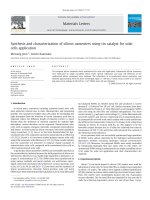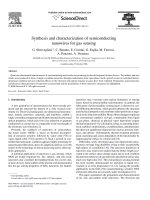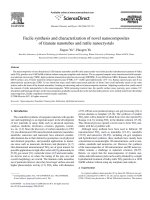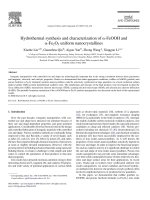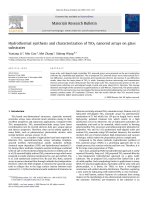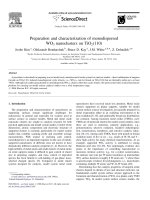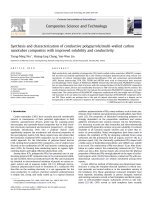- Trang chủ >>
- Khoa Học Tự Nhiên >>
- Vật lý
hydrothermal synthesis and characterization of tio2 nanorod arrays on glass substrates
Bạn đang xem bản rút gọn của tài liệu. Xem và tải ngay bản đầy đủ của tài liệu tại đây (615.33 KB, 6 trang )
Hydrothermal synthesis and characterization of TiO
2
nanorod arrays on glass
substrates
Yuxiang Li
a
, Min Guo
a
, Mei Zhang
a
, Xidong Wang
b,
*
a
Department of Physical Chemistry, University of Science and Technology Beijing, Beijing 100083, PR China
b
College of Engineering, Peking University, No. 5 of Yiheyuan Street, Haidian District, Beijing 100871, PR China
1. Introduction
TiO
2
-based one-dimensional structures, especially nanorod/
wire/tube arrays, have attracted much attention owing to their
excellent properties and important applications. Compared with
TiO
2
nanoparticles, TiO
2
nanorod/wire/tube arrays have lower
recombination rate for excited electron–hole pair, unique optical
and electric properties. Therefore, they can be widely applied in
many fields, such as photocatalyst, photovoltaic devices, solar
energy batteries and gas sensors [1–4].
In recent years, a number of approaches have been reported to
fabricate TiO
2
nanorod/wire/tube arrays, including template-
assisted method, electrochemical anodic oxidation method,
chemical vapor deposition (CVD) and hydrothermal method [5–
8]. Among these methods, template-assisted technique combined
with sol–gel or electrochemical deposit process is widely used. Lei
et al. [9] reported highly ordered TiO
2
nanowire arrays which were
prepared in anodic alumina membranes by a sol–gel method. Chu
et al. [10] synthesized ordered TiO
2
–Ru and TiO
2
–RuO
2
nanorod
arrays in porous alumina films through cathodic electrodeposition.
However, when the AAO template is removed, the nanorod arrays
tend to collapse due to the huge surface tension between each
nanorod [11–13]. Electrochemical anodic oxidation of titanium can
fabricate vertically oriented TiO
2
nanotube arrays. Paulose et al. [6]
fabricated self-aligned TiO
2
nanotube arrays by potentiostatic
anodization of Ti foil which has 134
m
m in length, but it needs
high-purity polished titanium foil, which results in a high
production cost [14]. Moreover, the as-fabricated nanotubes are
amorphous and need to be annealed, which results in forming
polycrystalline TiO
2
structures and influencing their photoelectric
properties. Wu and Yu [15] synthesized well-aligned rutile and
anatase TiO
2
nanorods using CVD method. However, this method
involves the use of metal catalyst, high-temperature and vacuum
technique, which makes the preparation process complicated.
Compared to the above methods, hydrothermal synthesis of
TiO
2
nanorod arrays (TNAs) is a promising approach due to its
simple process, fast reaction velocity and low cost. Therefore, it is
fit for large-scale preparation of TNAs.
Up to now, preparing TNAs by hydrothermal approach is rarely
reported. Recently, Feng et al. [16] prepared TiO
2
nanorod films by
a low-temperature hydrothermal approach on a glass wafer
substrate. The as-prepared TiO
2
nanorod film looked like a pile
of radial papillae. Such morphology limits its applications in many
fields. For practical applications, especially used for solar cells and
photocatalyst, it is better, for TNAs, to have a well-aligned
orientation and uniform density distribution. Therefore, exploring
a new route for fabricating well-ordered TNAs is very essential.
As is well known, surface features of a substrate have strong
impact on the morphology of one-dimensional material grown on
the substrate. Therefore, pre-treatment of the substrate is an
Materials Research Bulletin 44 (2009) 1232–1237
ARTICLE INFO
Article history:
Received 3 July 2008
Received in revised form 21 November 2008
Accepted 16 January 2009
Available online 22 January 2009
Keywords:
A. Nanostructures
B. Crystal growth
D. Catalytic properties
ABSTRACT
Large-scale, well-aligned single crystalline TiO
2
nanorod arrays were prepared on the pre-treated glass
substrate by a hydrother mal approach. The as-prepare d TiO
2
nanorod arrays were characterized by X-
ray diffraction, scanning electron microscopy and transmission electron microscopy. X-ray diffraction
results show that the main phase of TiO
2
is rutile. Scanning electron microscopy and transmission
electron microscopy results demonstrate that the large-scale TiO
2
nanorod arrays grown on the pre-
treated glass substrate are well-aligned single crystal and grow along [0 0 1] direction. The average
diameter and length of the nanorods are approximately 21 and 400 nm, respectively. The photocatalytic
activity of TiO
2
nanorod arrays was investigated by measuring the photodegradation rate of methyl blue
aqueous solution under UV irradiation (254 nm). And the results indicate that TiO
2
nanorod arrays
exhibit relatively higher photocatalytic activity.
ß 2009 Elsevier Ltd. All rights reserved.
* Corresponding author. Tel.: +86 10 8252 9083; fax: +86 10 6275 7532.
E-mail address: (X. Wang).
Contents lists available at ScienceDirect
Materials Research Bulletin
journal homepage: www.elsevier.com/locate/matresbu
0025-5408/$ – see front matter ß 2009 Elsevier Ltd. All rights reserved.
doi:10.1016/j.materresbull.2009.01.009
effective means to control the growth of TNAs. Guo [17] and Wang
and co-workers [18] prepared well-aligned ZnO nanorod arrays by
pre-treating the ITO glass substrate, and the results indicated that
pre-treatment of the substrate played an important role for the
growth morphology of ZnO nanorod arrays.
In this study, the substrate was pre-treated by coating TiO
2
nanoparticles followed by heat treatment, and then the pre-treated
substrate (PT-substrate) was put into hydrothermal solution to
fabricate TNAs. The growth mechanism of TNAs and influence of
PT-substrate on the morphology of the prepared TNAs have been
discussed. Furthermore, the photocatalytic activity of the prepared
TNAs was also investigated.
2. Experimental
2.1. Materials
All chemicals were of analytical reagent grade and used
without further purification. And all the aqueous solutions
were prepared using de-ionized water. The microscope slides
(1–1.2 mm thick), used as substrates, were firstly ultrasonic
cleaned by acetone, ethanol and de-ionized water, respectively
prior to use.
2.2. Preparation of the colloid solution for coating substrate
Firstly, 17 ml tetrabutyl titanate was dissolved in the mixed
solution of 12 ml ethanol and 5 ml diethanolamine, and then
stirred for 1 h to obtain a precursor solution. Secondly, the mixed
solution of 1.7 ml de-ionized water, 34 ml ethanol and 0.13 ml
hydrochloric acid (37% HCl) were added to the above precursor
solution and further violently stirred for 15 min. Finally, the as-
prepared mixed solution was aged for 24 h at room temperature in
order to form a homogeneous and stable colloid solution, which
served as the coating solution.
2.3. Pre-treatment of the substrate
The coating colloid solution was coated onto the cleaned glass
substrate using spin coater (KW-4A, made by the Chinese Academy
of Sciences) at the rate of 3000 rpm for 30 s. Subsequently, the
substrate was dried in air and annealed at 700 8C for 30 min in
muffle furnace. The process was repeated for two times to produce
TiO
2
nanocrystal seeds layer with appropriate thickness, and thus
the pre-treated substrate (PT-substrate) were prepared.
2.4. Hydrothermal growth of TNAs
The hydrothermal precursor solution was prepared by mixing
0.05 M titanium trichloride (TiCl
3
) aqueous solution saturated
with sodium chloride. After the precursor solution was stirred for
5 min, it was transferred into a polytetrafluoroethylene vessel
which was placed in a sealed kettle, and then PT-substrate was
immersed into the precursor solution, and subsequently, the
hydrothermal growth of TNAs was carried out at 160 8C for 3 h.
2.5. Characterization
The morphology and size distribution of the as-prepared TNAs
were characterized by the field-emission scanning electron
microscopy (FE-SEM, ZEISS SUPRA
TM
55 operated at 10 keV).
Transmission electron microscope (TEM, PHILIPS-FEI TECNAI20)
and high-resolution TEM (HRTEM, JEM-2010) were used to further
elucidate the microstructure and phase characterization. X-ray
diffraction (XRD) analysis was performed with a Rigaku D
MAX
-RB
diffractometer using Cu K
a
radiation.
2.6. Photocatalytic activity measurement
The photocatalytic activity of TNAs was investigated by
measuring the photodegradation rate of methyl blue aqueous
solution. Photocatalytic reaction was carried out in a
200 ml quartz glass vessel under which there was an 18 W
UV lamp (254 nm wavelength). The 0.1 g/l methyl blue a queous
solution (150 ml) and the as-prepared TNAs were placed into the
reaction vessel, keeping the face of TNAs upward. At the given
intervals of UV illumination, the specimen of methyl blue
solution was collected and analyzed using an UV spectro-
photometer (UNIC, UV-2100, absorption at
l
max
=600nm for
methyl blue).
3. Results and discussion
3.1. Morphology and crystal structure of TNAs
Modification of the substrate has strong impact on the
morphology and alignment ordering of TNAs. Fig. 1 shows the
FE-SEM photographs of TNAs grown on the unmodified glass
substrate. It can be seen from Fig. 1a that the unmodified substrate
is clean and nothing is observed on its surface, and TiO
2
nanorods
grow radially on the unmodified substrate and form many papillae
in a random pattern, as illustrated in Fig. 1b and c. The FE-SEM
photographs of TNAs grown on the pre-coated substrate without
heat treatment are shown in Fig. 2. It can be seen that the pre-
coated substrate (Fig. 2a) is different from the unmodified
substrate (Fig. 1a), which covered with a layer of film composed
of fine particles. Top view SEM images (Fig. 2b and c) show that
TNAs grow more vertically on the substrate and have a better
orientation after the substrate is coated with TiO
2
nanoparticles.
This phenomenon can be explained that the glass substrate is
amorphous and the distribution of nucleation sites is not uniform.
After TiO
2
colloid solution is coated onto the glass substrate, the
surface is covered with a layer of compact TiO
2
nanoparticles.
Although TiO
2
nanoparticles are amorphous, they can provide
uniform heterogeneous nucleation sites effectively. Therefore, the
as-prepared TiO
2
nanorods have relatively better growth orienta-
Fig. 1. FE-SEM images of TNAs grown on the unmodified glass substrates at a hydrothermal growth temperature of 160 8C and growth time of 3 h. (a) Unmodified glass
substrate; (b and c) top view at different magnifications of TNAs.
Y. Li et al. / Materials Research Bulletin 44 (2009) 1232–1237
1233
tion and density distribution compared with those grown on the
unmodified substrate.
Fig. 3 shows XRD patterns of the different substrates, which
identify the phase structure of the substrates. From Fig. 3, it can be
seen that a wide peak in the angle range of 2
u
= 15–358 appears in
all XRD patterns, which is due to the influence of amorphous phase
of the glass substrate. Fig. 3a is XRD patterns of the unmodified
glass substrate, and no other peaks appear. Fig. 3b shows XRD
patterns of the substrate with pre-coated TiO
2
nanoparticles but
not annealed. It can be seen that there is still no other peaks of
crystalline TiO
2
, indicating that TiO
2
nanoparticles on the substrate
are amorphous. When the substrate is coated with TiO
2
nanoparticles followed by heat treatment at 700 8C, it can be
seen from Fig. 3c, although existing the noise signal from the glass
substrate, the diffraction peaks of TiO
2
appear and can be indexed
as the rutile phase (JCPDS No. 04-0551) and the anatase phase
(JCPDS No. 01-0562) of TiO
2
, suggesting that most of TiO
2
nanoparticles transform from amorphous to rutile phase, but
partial TiO
2
nanoparticles are anatase phase.
When the substrate is coated with TiO
2
nanoparticles followed
by heat treatment at 700 8C, it is clearly observed from Fig. 5a that
there is a mass of uniform particles with rutile crystalline phase
(Fig. 3c) on the substrate.
Fig. 4 shows XRD patterns of standard rutile phase (JCPDS No.
04-0551), standard anatase phase (JCPDS No. 01-0562) of TiO
2
and
TNAs grown on the different substrates. Fig. 4a shows XRD patterns
of TNAs grown on the unmodified glass substrate, which shows
that the main phase is rutile phase of TiO
2
. It can be seen from
Fig. 4b that the intensity of 1 1 0 peak of rutile phase increases
when TNAs grew on the substrate with pre-coated TiO
2
nanoparticles but not annealed. As shown in Fig. 4c, after the
pre-coated substrate was annealed, the diffraction intensity of
(1 1 0) planes increases even significantly. A number of works [19–
22] have reported that the prepared TiO
2
rods via hydrothermal
approach in strongly acidic solution are usually pure rutile phase.
This is in consistent with the results of XRD in this work. However,
a small part of anatase phase of the as-prepared TNAs was detected
by XRD, which might be due to the coated TiO
2
nanocrystal
particles on the glass substrate. From Fig. 4, we also see that the
diffraction intensity ratio of (1 1 0) to (1 0 1) becomes larger than
that of the standard rutile phase of TiO
2
, indicating that the as-
prepared TNAs prefer to grow along the (1 1 0) planes.
As is shown in Fig. 5a, after annealed at 700 8C, there is a mass of
uniform particles on the substrate serving as the seeds on which
TiO
2
nanorods grow. Therefore, during hydrothermal reaction
process, TiO
2
crystalline nucleus is apt to form on the coated TiO
2
particles and grow along the (1 1 0) planes. As a result, TNAs can
grow on PT-substrate with well orientation and uniform density
distribution, as can be seen from Fig. 5b.
Fig. 5c is the side view SEM image of TNAs grown on PT-
substrate. It can be seen that there is a layer of TiO
2
nanocrystal
particles film of about 200 nm in thickness (marked by d1)
between TiO
2
nanorod arrays and the glass substrate (marked by
d2). The length of TiO
2
nanorods ranges from 300 to 500 nm. From
the preliminary experiment, we found the following phenomena.
When the substrate is coated for one time, the thickness of the seed
layer is thinner (about 90 nm). However, the TiO
2
crystal seeds are
not uniformly distributed on the substrate. As a result, the
orientation of TiO
2
nanorod arrays grown on the substrate
becomes poor.
In addition, the diameter distribution of TiO
2
nanorods grown
on PT-substrate is illustrated in Fig. 6. Statistics show that 70% of
Fig. 2. FE-SEM images of TNAs grown on the TiO
2
-coated substrate without heat treatment at a hydrothermal growth temperature of 160 8C and growth time of 3 h. (a) PT-
substrate without heat treatment; (b and c) top view at different magnifications of TNAs.
Fig. 3. XRD patterns of the different substrates. (a) Unmodified glass substrate; (b)
PT-substrate without heat treatment; (c) PT-substrate at an annealing temperature
of 700 8C.
Fig. 4. XRD patterns of standard rutile phase (JCPDS No. 04-0551), standard anatase
phase (JCPDS No. 01-0562) of TiO
2
and TNAs grown on: (a) unmodified glass
substrate; (b) PT-substrate without heat treatment; (c) PT-substrate at an annealing
temperature of 700 8C.
Y. Li et al. / Materials Research Bulletin 44 (2009) 1232–1237
1234
the nanorods have a diameter between 15 and 25 nm and the
average diameter of TiO
2
nanorods is about 21 nm. Compared with
the TNAs reported previously [11,16], the as-prepared TNAs in this
work have been improved in the growth orientation, the density
distribution and the aspect ratio.
It can be seen from XRD patterns and SEM images, that the
crystallinity of the prepared nanorods is low. In order to improve
the quality of TiO
2
nanorods, TNAs were prepared under
hydrothermal temperature of 190 8C. The SEM image (Fig. 7)
shows obvious tetragonal structure of rutile, which exhibits a
better crystallinity of TiO
2
nanorod. However, it can be seen from
Fig. 7 that the growth orientation becomes poor, and the diameter
distribution of TiO
2
nanorods becomes wide.
The microstructure of TiO
2
nanorods was further analyzed
using TEM and HRTEM. Two rods with a diameter of about 4 nm
were selected for study. Fig. 8a shows the TEM image and the
associated selected area electron diffraction (SAED) pattern of TiO
2
nanorods. The SAED inserted in the upper left corner of Fig. 8a
demonstrates that TiO
2
nanorod is a single crystal. High-resolution
TEM image of one single TiO
2
nanorod is shown in Fig. 8b. The
lattice fringes indicate that TiO
2
nanorod is well crystallized. The
spacing between two fringes is 0.325 nm, corresponding to the
interplanar distance of the (1 1 0) index planes of the rutile TiO
2
,
indicating that the as-prepared TiO
2
nanorods via hydrothermal
approach are the rutile structure. Furthermore, it is observed that
the (1 1 0) crystal planes are perpendicular to the c-axis, implying
Fig. 5. FE-SEM images of TNAs grown on PT-substrate at an annealing temperature of 700 8C and at a hydrothermal growth temperature of 160 8C and growth time of 3 h. (a)
PT-substrate; (b) top view of TNAs; (c) side view of TNAs.
Fig. 6. Diameter distribution of TiO
2
nanorods grown on PT-substrate at an
annealing temperature of 700 8C and at a hydrothermal growth temperature of
160 8C and with growth time of 3 h.
Fig. 7. SEM image of TiO
2
nanorod arrays grown on the substrate at an annealing
temperature of 700 8C at a hydrothermal growth temperature of 190 8C and growth
time of 3 h.
Y. Li et al. / Materials Research Bulletin 44 (2009) 1232–1237
1235
that TiO
2
nanorods grow along the (1 1 0) crystal planes, and this is
consistent with the results of XRD.
Considering the effect of annealing temperature, the pre-coated
substrates were annealed at 450 and 600 8C, respectively. However,
after hydrothermal reaction, TiO
2
nanorods have not grown on the
substrate with annealed at 450 8C, TiO
2
nanorods begin to grow but
the morphology is very poor when the annealing temperature
increases to 600 8C. Therefore, 700 8C was chosen as the annealing
temperature of the PT-substrates in the present experiment.
3.2. Growth mechanism of TNAs
Growth of TiO
2
nanorods on the substrate is strongly related to
rutile’s inherent growth habit and hydrothermal preparation
conditions. The structure of rutile consists of chains of TiO
6
octahedra along the c-axis [23]. The TiO
6
octahedra in the chain
connect through one shared edge, while the TiO
6
octahedra
between two chains connect through points, which implies that
the chemical band in the chain is stronger than that between the
chains. According to PBC theory [24–26], periodic bond chain
constructs the crystal, and the direction of the strongest chemical
bond is usually the direction in which the crystal has the fastest
growth velocity. Therefore, for rutile TiO
2
crystal, the growth
velocity along the [0 0 1] direction is faster than that of the [1 1 0]
direction. However, as for the structure of anatase TiO
2
, all the TiO
6
octahedra connect through shared edges, which results in the same
growth velocity in all directions. It is the reason that the as-
prepared TiO
2
nanorods are rutile phase instead of anatase phase.
The formation of rutile crystal nucleus in TiCl
3
strongly acidic
precursor solution can be described by the following process [27].
First, single polymer [TiO(OH
2
)
5
]
2+
forms by the following reactive
equations:
Ti
3þ
þ 6H
2
O !½TiðOH
2
Þ
6
3þ
(1)
½TiðOH
2
Þ
6
3þ
!½TiðOHÞðOH
2
Þ
5
2þ
þ H
þ
!½TiOðOH
2
Þ
5
þ
þ 2H
þ
(2)
4½TiOðOH
2
Þ
5
þ
þ O
2
þ 4H
þ
! 4½TiOðOH
2
Þ
5
2þ
þ 2H
2
O (3)
Then the single polymers [TiO(OH
2
)
5
]
2+
combine through
dehydrating each other to form straight chain polymer by the
edge connection. Finally, the straight chain polymers connect
through points to form rutile crystal nucleus.
As is well known, the heterogeneous nucleation of crystalline
phase in solution is easier than homogeneous nucleation [28].
Therefore, TiO
2
nanocrystal particles coated onto the glass
substrate followed by heat treatment can be served as the seeds
of heterogeneous nucleation. Moreover, the structure of crystalline
seeds matches that of the prepared single crystal nanorods, which
make well-aligned nanorod arrays be prepared.
In addition, Cl
À
plays a significant role when TiO
2
growth units
deposit on TiO
2
crystal seeds, and it can promote TiO
2
crystal to
grow into rods instead of particles. As is shown in Fig. 9, when NaCl
is not added to the hydrothermal precursor solution, TiO
2
arrays
grown on PT-substrate almost do not grow into rods. It can be
explained that the (1 1 0) plane of rutile is positive polar-face and
Cl
À
will be adsorbed preferentially on its surface, which prevents
the contact of the TiO
2
growth units on the (1 1 0) surface and thus
greatly limits the crystal growth along the (0 0 1) planes. There-
fore, Cl
À
may be the key factor for TiO
2
crystal growing along
[0 0 1] direction to form rod-like structure.
3.3. Photocatalytic property of TNAs
Fig. 10 shows photodegradation rate curves of TNAs grown on
different substrates and TiO
2
nanoparticles for methyl blue
Fig. 8. TEM images of TiO
2
nanorods grown on PT-substrate at an annealing
temperature of 700 8C and at a hydrothermal growth temperature of 160 8C and
with growth time of 3 h. (a) TEM image and the associated selected area electron
diffraction of TiO
2
nanorods; (b) lattice fringes image of high-resolution TEM of one
single TiO
2
nanorod at the side surface.
Fig. 9. FE-SEM image of the as-prepared TiO
2
arrays grown on PT-substrate when
NaCl is not added to the hydrothermal precursor solution at a hydrothermal growth
temperature of 160 8C and with growth time of 3 h.
Fig. 10. Photodegradation rate curves of TiO
2
nanoparticles (a) and TNAs grown on
different substrates for methyl blue solution: (b) PT-substrate without heat
treatment; (c) PT-substrate; (d) unmodified substrate. Hydrothermal growth
temperature: 160 8C and growth time: 3 h.
Y. Li et al. / Materials Research Bulletin 44 (2009) 1232–1237
1236
solution. The curves of C/C
0
versus irradiation time reveal the
concentration change of methyl blue solution as the photocatalytic
reaction proceeds. The used TiO
2
nanoparticles are prepared by sol–
gel method and annealed at 450 8C, which is pure anatase phase. The
TiO
2
nanoparticles have a diameter of approximately 11 nm, and the
specific surface area is about 40.74 m
2
/g. In the contrast experi-
ments, the mass of TiO
2
nanoparticles and three kinds of TNAs
adding to methyl blue solution is 0.02 and 0.006 g (excluding the
pre-coated particle on the substrate), respectively. From Fig. 10,it
can be seen that although the addition quantity of TNAs is much less
than that of TiO
2
nanoparticles, it has relatively higher photode-
gradation rate. In addition, three kinds of TNAs grown on different
substrates have similar photocatalytic activity. The higher photo-
catalytic activity of TNAs may result from its crystal structure and
distribution of the arrays. TiO
2
nanoparticles have much more grain
boundary than that of single crystalline TNAs, which will make it
easier for the recombination of electron and hole pair. On the other
hand, TiO
2
nanoparticles may be agglomerated together and reduce
the surface area, while the distribution of the TNAs will protect it
from agglomeration. As a result, the photocatalytic activity greatly
improves with the prepared TNAs.
4. Conclusions
Large-scale, well-aligned TNAs were fabricated on the modified
glass substrate using hydrothermal approach. It has been
demonstrated that TNAs grown on PT-substrate have a better
growth orientation and uniform density compared with those
grown on the unmodified substrates. TiO
2
nanorod is a single
crystal rutile structure with growth direction along the (1 1 0)
crystal planes. About 67% of TiO
2
nanorods have a diameter
between 15 and 25 nm and the average diameter is about 21 nm,
and the length of TiO
2
nanorods ranges from 300 to 500 nm. In
addition, it indicates that TiO
2
nanoparticles coated on glass
substrate are not completely transformed into rutile phase after
heat treatment at 700 8C, and the (1 1 0) planes are the preferred
orientation. The photodegradation experiment implies that single
crystal TNAs have a relatively higher photocatalytic activity
compared with polycrystal TiO
2
nanoparticles. This work demon-
strates that the substrate pre-treatment has a strong impact on the
growth morphology of TNAs and provides a very promising
approach for the nanorod arrays preparation.
Acknowledgements
The authors would like to thank the National Science
Foundation of China for the financial support (Nos. 50425415
and 50772004) and National Basic Research Program of China (973
Program: 2007CB613608).
References
[1] X.H. Xia, Y.S. Luo, Z. Wang, Y. Liang, J. Fan, Z.J. Jia, Z.H. Chen, Mater. Lett. 61 (2007)
2571.
[2] Q. Wei, K. Hirota, K. Tajima, K. Hashimoto, Chem. Mater. 18 (2006) 5080.
[3] G.K. Mor, K. Shankar, M. Paulose, O.K. Varghese, C.A. Grimes, Nano Lett. 6 (2006)
215.
[4] I.D. Kim, A. Rothschild, B.H. Lee, D.Y. Kim, S.M. Jo, H.L. Tuller, Nano Lett. 6 (2006)
2009.
[5] W. Ho, J.C. Yu, J.G. Yu, Langmuir 21 (2005) 3486.
[6] M. Paulose, K. Shankar, S. Yoriya, H.E. Prakasam, O.K. Varghese, G.K. Mor, T.A.
Latempa, A. Fitzgerald, C.A. Grimes, J. Phys. Chem. B 110 (2006) 16179.
[7] S.K. Pradhan, P.J. Reucroft, F. Yang, Dozier, J. Cryst. Growth 256 (2003) 83.
[8] Z.R. Tian, J.A. Voigt, J. Liu, B. Mckenzie, H. Xu, J. Am. Chem. Soc. 125 (2003) 12384.
[9] Y. Lei, L.D. Zhang, G.W. Meng, G.H. Li, X.Y. Zhang, C.H. Liang, W. Chen, Appl. Phys.
Lett. 78 (2001) 1125.
[10] S.Z. Chu, K. Wada, S. Inoue, S.I. Hishita, K. Kurashima, J. Phys. Chem. B 107 (2003)
10180.
[11] J. Zuo, C.G. Nie, X. Gu, Y.K. Lai, Y. Zong, L. Sun, C.J. Lin, Mater. Lett. 61 (2007) 2632.
[12] M. Barbic, J.J. Mock, D.R. Smith, S. Schultz, J. Appl. Phys. 91 (2002) 9341.
[13] D. Xu, Y. Xu, D. Chen, G. Guo, L. Gui, Y. Tang, Chem. Phys. Lett. 325 (2000)
340.
[14] O.K. Varghese, D. Gong, M. Paulose, K.G. Ong, E.C. Dickey, C.A. Grimes, Adv. Mater.
15 (2003) 624.
[15] J.J. Wu, C.C. Yu, J. Phys. Chem. B 108 (2004) 3377.
[16] X.J. Feng, J. Zhai, L. Jiang, Angew. Chem. Int. Ed. 44 (2005) 5115.
[17] M. Guo, P. Diao, S.M. Cai, J. Solid State Chem. 178 (2005) 1864.
[18] T. Ma, M. Guo, M. Zhang, Y.J. Zhang, X.D. Wang, Nanotechnology 18 (2007)
035605.
[19] Y.H. Jiang, H.B. Yin, Y.M. Sun, H. Liu, L.X. Lei, K.M. Chen, Y.J. Wada, Appl. Surf. Sci.
253 (2007) 9277.
[20] M.N. Tahir, P. Theato, P. Oberle, G. Melnyk, S. Faiss, U. Kolb, A. Janshoff, M.
Stepputat, W. Tremel, Langmuir 22 (2006) 5209.
[21] K. Kakiuchi, E. Hosono, H. Imai, T. Kimura, S. Fujihara, J. Cryst. Growth 293 (2006)
541.
[22] J. Yang, S. Mei, J.M.F. Ferreira, P. Norby, S. Quaresma
ˆ
, J. Colloid Interf. Sci. 283
(2005) 102.
[23] X. Bokhimi, A. Morales, M. Aguilar, J.A. Toledo-Antonio, F. Pedraza, Int. J. Hydrogen
Energy 26 (2001) 1279.
[24] P. Hartman, W.G. Perdok, Acta Cryst. 8 (1955) 49.
[25] P. Hartman, W.G. Perdok, Acta Cryst. 8 (1955) 521.
[26] P. Hartman, W.G. Perdok, Acta Cryst. 8 (1955) 525.
[27] E.W. Shi, Z.Z. Chen, R.L. Yuan, Y.Q. Zheng, Hydrothermal Crystallography, Science
Press, Beijing, 2004, p. 150.
[28] L. Vayssieres, K. Keis, S.E. Lindquist, A. Hagfeldt, J. Phys. Chem. B 105 (2001) 3350.
Y. Li et al. / Materials Research Bulletin 44 (2009) 1232–1237
1237
